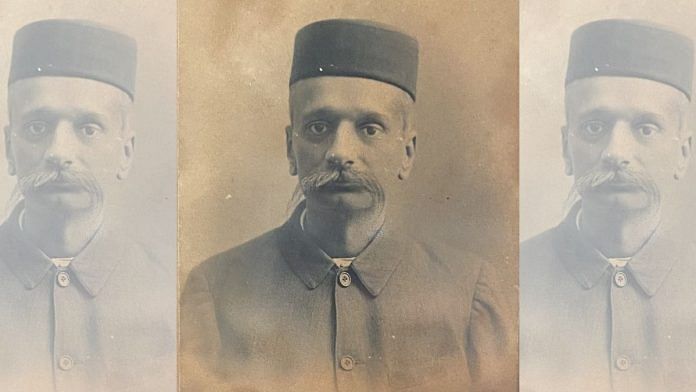Tribhuvandas K. Gajjar, ‘a pioneering industrial chemist of western India’, was the founder of Kala Bhavan, a first polytechnic of its kind under the patronage of Maharaja Sayajirao Gaekwad of Baroda. He introduced synthetic dyes to the Indian textile industry and was a strong advocate for the swadeshi industries. His focus was on the practical application of scientific knowledge with mother tongue as a medium of education. (Current Science, Rajesh Kochhar, Vol. 104, NO. 8, 25 April 2013, page 1093)
Born into a wealthy carpenter family in Surat, Gajjar completed his B.Sc. from Elphinstone College Bombay and was appointed a fellow there. He had a wide range of interests, including maths and physics, and even studied medicine at Grant Medical College for some time. He also began studying law with his friend Chimanlal Setalvad. However, his true passion was chemistry, and he received his M.Sc. in this field at the age of 21. (Professor Tribhuvandas Kalyandas Gajjarni Jeevankatha, by Dr. Ashwin Trivedi, Prof. Sankalchand Shah, Dr. Rasiklal Shah, 1960, MS Univeristy, Page 4)
Scientific knowledge for practical purpose
Gajjar received job offers from several colleges, including Gujarat College in Ahmedabad, but he had different plans. He believed in using his scientific knowledge for practical purposes and for the benefit of the nation. His ambition was to use his knowledge to develop the country’s crafts.
Gajjar had planned to establish the first polytechnic in Surat with Tapidas Sheth, who was willing to donate Rs two lakh for the project. However, Sheth’s untimely death put an end to these plans. Instead, Gajjar accepted a job in Baroda, considering the progressive mindset of its ruler, Sayajirao Gaekwad. He began as a professor of chemistry at Baroda College.
Gajjar was a firm believer in education in one’s mother tongue and founded a Vernacular Academy to promote this idea. Along with his Marathi friend Yashwant B. Athlye, he conceived a series of books on science and various other subjects in Gujarati and Marathi. Sayajirao sanctioned Rs 50,000 for this project, which resulted in two series: Sayaji Gnanmanjusha and Sayaji Laghu Gnanmanjusha, both headed by Gajjar. He also envisioned an ambitious project of a multilingual thesaurus of terminology covering English, Gujarati, Marathi, Hindi, Bengali and Sanskrit. However, this project remained unfinished.
Impressed with Gajjar’s idea of a polytechnic, Sayajirao founded Kala Bhavan in 1890 and appointed Gajjar as its first principal. Reflecting Gajjar’s emphasis on practical training, Kala Bhavan was divided into six sections: Chitrashala-the arts school, Yantrashala-a technical institute, Rasayan ane Rangshala—the school for chemicals and dyeing, Agriculture Institute, Sculpture and Engineering school and a school for language and pedagogy. The medium of instruction was Gujarati and English taught as a language. Dadasaheb Phalke, a pioneer of Indian Cinema, was one of the students of Kala Bhavan. (Current Science, Page 1095)
Gajjar’s influence extended beyond the classroom, as he also played a pivotal role in establishing various dyeing schools across India, which became instrumental in advancing the textile industry.
Rajesh Kochhar highlighted an important distinction in Current Science, noting that while Western education primarily benefited the upper castes, Gajjar successfully extended its benefits to artisan castes. Out of 294 students at Kala Bhavan, 41 per cent were from artisan castes, farmers and cultivators. (Current Science, page 1095) Gajjar introduced synthetic dyes to the Indian textile industry and conducted studies in dyeing colour and printing. He inspired and supervised many dyeing schools in places like Ahmedabad, Wankaner, Delhi, Amritsar, Kanpur etc. For Gajjar, chemistry was more than just a career; it was his passion. As a result, he started a Gujarati monthly Rang Rahasya for industrial training and funded it himself.
After leaving Kala Bhavan due to bureaucratic issues and internal politics, Gajjar joined Wilson College as a chemistry professor. He established a laboratory within the college, which later expanded into the full-fledged Techo Chemical Laboratory at Girgaum. When nationalists Damodar Chapekar tarred Queen Victoria’s marble statue in Bombay, and all cleaning attempts failed, Gajjar successfully cleaned the statue in three months, and charged Rs 5,000 as fees. When the government and the municipality expressed their inability to pay the bill, it was bore by the Sheriff of Bombay, Adamji Pirbhai. Gajjar also discovered a pearl-cleaning method that brought him considerable wealth. In addition to chemical analysis, he produced medicines in his laboratory.
Also read: Cocaine, Jinnah, films, azan call—Visami Sadi set benchmark for Gujarati photo magazines
Laboratory development
Gajjar invested a significant portion of his wealth in his laboratory’s development. His laboratory was approved by the Bombay University for the study of M.Sc. Chemistry. Students from Wilson College and St. Xavier’s College relied on Gajjar’s laboratory, which produced 257 students within its first ten years since its inception in 1899. His student Anant Kotibhaskar established Alembic Chemical Works in Baroda, with Gajjar playing a crucial role in securing investment for the project. Another student, Bhailal Amin, also joined Alembic. Kotibhaskar’s untimely death led Gajjar back to Baroda for a while to take charge of Alembic.
With great wealth came legal battles over several disputes, particularly in the pearl-cleaning business. Gajjar developed and patented a medicine for the influenza pandemic in 1918. He earned significantly from this and generously funded many of his projects. He spent his final years in Surat. Despite receiving invitations from Sir Ashutosh Mukherji and Pandit Madan Mohan Malaviya, his health did not permit him to accept them. He had close associations with many prominent writers and poets of his time, including Govardhanram Tripathi, the author of the first Gujarati magnum opus Saraswatichandra, who passed away in Gajjar’s Bombay bungalow.
Upon Gajjar’s death, Gandhi wrote in Navjivan that only Dr. (P.C.) Roy and Dr. (J.C.) Bose could be compared to him in terms of contributions. However, Gujarat did not remember him as fondly as Bengal remembered his contemporary P.C. Ray.
Urvish Kothari is a senior columnist and writer based in Ahmedabad. He tweets @urvish2020. Views are personal.
(Edited by Anurag Chaubey)






